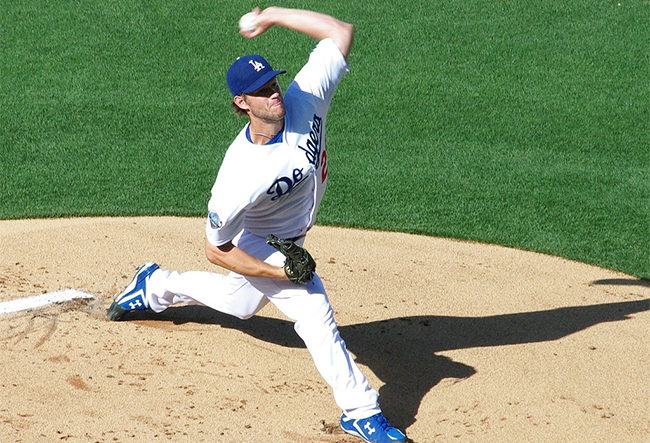
When I started looking at the Pitch FX data for Clayton Kershaw‘s no-hitter, I was expecting to find something that stuck out. Did his pitches break more? Were the pitches faster? Let’s compare his numbers from last night to the rest of the season for each pitch (excluding the changeup since he only threw two).
First, the velocities:
| Pitch | No Hitter Velocity | 2014 Average |
| Fastball | 94.03 | 93.83 |
| Slider | 87.36 | 87.83 |
| Curveball | 74.72 | 74.93 |
Now, the movement:
| Pitch | Horizontal movement (inches) | Vertical movement (inches) | ||
| No Hitter Average | 2014 Average | No Hitter Average | 2014 Average | |
| Fastball | 1.16 | 1.32 | 12.33 | 11.94 |
| Slider | -3.00 | -2.32 | 4.04 | 4.14 |
| Curveball | -2.53 | -2.64 | -8.00 | -8.58 |
All of the numbers above are close to their 2014 averages and are within the range of values which have already happened this year. The exception is the slider, which had the most horizontal movement of the season last night. However, the pitch averaged higher movement in every season between 2009 and 2013, and last night’s departure from average was less than an inch.
Really, the most impressive part about Clayton Kershaw’s no-hitter, one of the best individual pitching performances of all time, was not that his stuff was better. It’s that it wasn’t. There was no level for him to reach for, he just did what he has been doing all year. He could just have easily have done it before today with the same types of pitches.
—
The curveball is Kershaw’s big, flashy pitch, the most aesthetically pleasing; it’s very GIFable. The pitch is frequently taken for strikes and generates weak contact. It keeps hitters off balance. It’s why Kershaw’s contract has been viewed as a bargain and why he is on a hall of fame career trajectory. It’s a true 80-grade pitch. It gets a lot of attention, and it deserves it.
However, I want to dwell somewhere else for this rest of this post. The curve is Kershaw’s prettiest pitch, but his slider should not be overlooked. Jeff Sullivan already wrote a fantastic post on the pitch earlier today, focusing on its evolution over the years and why it is better than ever in 2014. It’s worth your time, so go read that and come back.
Last night, Kershaw induced 22 swinging strikes, a career high. Via the excellent Baseball Savant, here’s a plot with all of them:
You can put the swinging strikes into three separate “categories.” The first category is comprised of high fastballs (6 of 22 pitches). The second category is the curves (4 of 22). The third and largest category, twelve of the 22 pitches, is low sliders, mostly on the left side of the plate or outside the strike zone in the same area.
Ten of the twelve swinging strikes in the third category were by right-handed hitters, the sliders diving towards their back foot. Here’s an example:
It’s a tool which Kershaw uses to help reduce the platoon advantage that right-handed batters theoretically have against him. Let’s look further into the pitch. For the purposes of the rest of this post, a “back foot” slider is either in the low and inside portion of the strike zone, or off the plate in the same general area.
Kershaw has thrown the back-foot slider to right-handed batters 820 times since the beginning of 2011. Here’s what batters did with the pitch:
| Category | Occurrences | Rates |
| Swing | 509 | 62.1% |
| Whiff | 311 | 37.9% whiff/pitch 61.1% whiff/swing |
| Foul | 137 | 16.7% |
| In play, hit | 16 | 2.2% |
That’s a bunch of numbers which show that the pitch is really, really good. And there’s more. Since the start of 2011, Kershaw has 573 strikeouts against right-handed batters. 143 of the strikeouts (25%) have been on a back-foot slider. 140 of those strikeouts were swinging.
Last night, Kershaw threw 16 back-foot sliders. Batters swung at the pitch 14 times, missed 10 times, and never put it into play. Four of his fifteen strikeouts were on the pitch, to a specific handedness of batter, in a very specific spot.
Sullivan’s article wrote at length about how Kershaw has been getting his slider low in the zone at a significantly higher rate so far this season. More low sliders means more back-foot sliders. We already established that Kershaw’s stuff last night wasn’t unusual, and we know that the locations were good as well. If he can remain consistent and throw the pitch as well as he did last night, the results will be phenomenal.
 Dodgers Digest Los Angeles Dodgers Baseball Blog
Dodgers Digest Los Angeles Dodgers Baseball Blog
